
Photos of a Formula Oneconcept car for the 2021 season popped up on Twitter earlier this week, and, aside from the routine rules overhaul planned for that year, the photos had almost no context at all. But F1 stepped in a few hours ago to give us all the context we needed, and it turns out what we’re seeing is the future of the sport.
That future, at least while the cars are standing still, looks good.
F1 does a rules overhaul every few years, like when it got rid of its wonderfully loud V8 engines in favor of hybrid V6 turbos in 2014. The next big overhaul is for the 2021 season, where F1 has said it wants to make the cars louder, and the competition cheaper and more fair from team to team. That latter part is a big change from the current system, which has a huge performance gap between the teams depending on how much cash and development work they have.
There are new cars in the works for 2021, too, and the photos came up earlier this week during what Autosport reported to be a technical seminar before this weekend’s Singapore Grand Prix. Only one car photo was in the mix of the stuff on Twitter, labeled “Concept 2” on the slide. It made us wonder: Were there multiple concepts for F1 to decide between? Why was there a “2” at the end?
Advertisement
But without context, we were looking at it all wrong.
F1 posted its own photos of the concepts on Friday, saying the numbers at the end weren’t to label options—the numbers mark stages of development instead. Designers started with Concept 1, a tweaked version of the car F1 has right now, then went to Concept 2, and so on. F1 expects to have a framework for the 2021 car it decides to go with by next year.
The whole goal with the car, as the F1 press release on it said, is to “increase the chances of great fights, all the way down the field, every year.” The sport also wants cars to be able to follow each other more easily, which “should increase the opportunities to overtake.”
Advertisement
Oh, and F1 wants the cars to look really, really good. From the press release:
“When we started looking at the 2021 car, the primary objective was to enable the cars to race well together,” says Formula 1 motorsport boss Ross Brawn. “What we established early on in our research is the cars we have now are very bad in following each other.
“Once the cars get within a few car lengths of each other, they lose 50% of their downforce. That’s a substantial amount of performance lost. So we set about understanding why that was and how we can improve it. I’m pleased to say we’re at about 80%. […]”
Advertisement
Here’s where the design work started, with a tweaked version of the current car:
Then the designers moved onto a second version of the concept car, which the F1 release called “more refined and stylistically more aggressive.” It looks to have a smoother and simpler front wing and bodywork in general, along with a more flowing look to the rear wing.
Advertisement
The wheels are bigger, too, Brawn said, because F1 is “committed to 18-inch wheels for the future.” He said they look better, and that there are “a lot of technical reasons” why F1 wants them.
Advertisement
In comes the third concept, which F1 said is the most current. It has the front wing with the tall side pieces sticking up like the concept we saw yesterday, a completely different rear wing and more angular, sharper bodywork.
F1 said over the summer that it wants to lower aerodynamic outwash from the front wing—which means, in normal speak, to lessen the amount of air going to the outside of the tire—and the press release said this concept shows “the first signs of devices to control the way the airflow comes of the wheels.”
From the release:
“The tyres and the wheels are the dirtiest area of the car, they cause huge disruption in the airflow,” says Brawn. “We are starting to look at devices that can stabilise the flow as it comes of the wheel. It’s maturing as we go along.”
Advertisement
It’s hard to get past the huge jumble of photos to see exactly what changed from concept to concept, so here’s a set that shows the current car and all of the new concepts, in order. Hopefully, it’ll make all of the changes easier to decipher:
Advertisement
The concepts look good, honestly. And if they do what they’re supposed to do—make the racing closer and more competitive from team to team—they’ll make for a good show on track, too.













